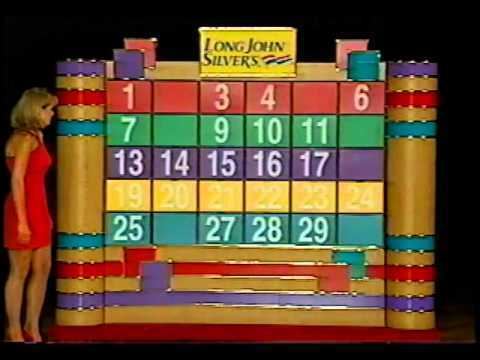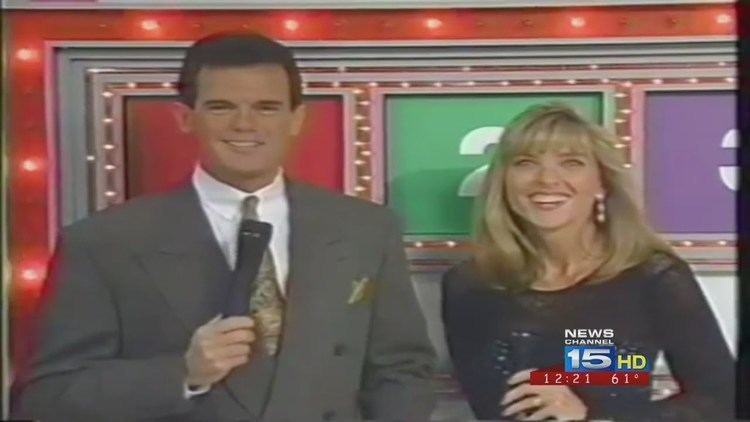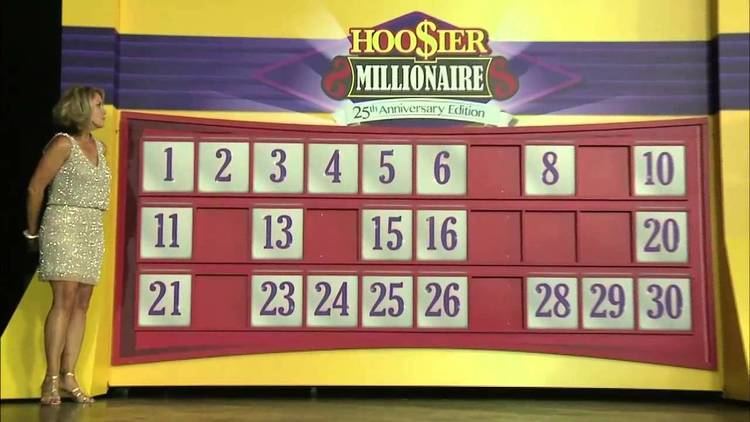Country of origin United States No. of episodes 780 First episode date 28 October 1989 Number of seasons 16 Genre Game show | No. of seasons 16 Running time 30 minutes Final episode date 19 November 2005 Number of episodes 780 | |
 | ||
Presented by Mark Patrick (1989–2003)Barbara Hobbs (1989–2003)Cody Stark (2003–2005)Catt Sadler (2003–2005)Tony Lamont (2004–2005) Narrated by Tony Lamont (1989–2004) Similar Game show, Illinois Instant Riches, The Daily 10, Flamingo Fortune, Make Me a Millionaire | ||
Hoosier millionaire may 26 1990
Hoosier Millionaire is an American television lottery game show which aired on television stations in the sate of Indiana from October 28, 1989 to November 19, 2005.
Contents
- Hoosier millionaire may 26 1990
- Hoosier millionaire episode 491 march 20 1999
- Broadcast history
- Original rules
- Bonus round
- 25th Anniversary Show
- References

Hoosier millionaire episode 491 march 20 1999
Broadcast history

The game show began on WTTV/WTTK (Channel 4/29) in Indianapolis/Bloomington/Kokomo. Other stations airing the show on a statewide network upon the program's debut included:


With Marion-licensed WNDY (Channel 23) trying to establish itself in Indianapolis, and with the new ownership of Indianapolis Motor Speedway owner Tony George, the Lottery moved the show to that station in February 1996, resulting in a few changes in the statewide network;


WLFI continued to carry the show in Lafayette, while the show moved in the Chicago market due to WGBO's conversion to an owned-and-operated station of the Spanish language Univision network.
During the 1990s, the show was sponsored by Long John Silvers, with their logo on top of the main gameboard. In addition, the show would also spotlight a "Hoosier Lottery retailer of the week" at the end of the show; in the early 1990s they would also spotlight an "[Indiana] county of the week".
Four years later, a new format called "The New Hoosier Millionaire" premiered in January 2000 and returned to WTTV. The budget was essentially cut, with the $1,000,000 grand prize available every 13 weeks instead of on every show. The set became a black room with contestant podiums and a game board. The lowest dollar amount on the regular game board was increased to $2,000. More changes to the statewide network occurred:
In June 2003, a whole new format emerged, and Tribune Broadcasting took over productions with their purchase of WTTV/WTTK from Sinclair Broadcast Group in 2003 to form a station duopoly in Indianapolis. The new management forced out Mark Patrick and Barbara Hobbs. Cody Stark and Catt Sadler, who were part of WXIN's "Fox 59 Morning News", took over hosting duties, and the program immediately moved to the higher-rated station. WKEF (a Sinclair station and WTTV's sister station before the WTTV/WTTK sale) dropped the program with no other Dayton/Eastern Indiana station taking its place, while in the Chicago area, the program moved to PBS member station WYIN (Channel 56, Gary), one of the few times a lottery game show has aired over a public television station, and WEVV (Channel 44) aired the show in Evansville. Ratings declined for two more years until Hoosier Millionaire's cancellation early in its sixteenth season in the fall of 2005.
Original rules
Six contestants each picked at least three numbers (this was known as rounds 1-3) from the game board, numbered 1–30. The dollar amounts ranged from $1,000 to $10,000 (with $1,000 and $2,000 being the most common). There were also two bonus prizes (typically 5,000 Hoosier Lottery Scratch-Off tickets and a trip sponsored by ATA) on the board that "did not count towards a contestant's cash prize total" (that is, the contestant got to pick again until uncovering a number with a dollar amount). Round 3 eliminates the four contestants with the lowest dollar amounts until there are only two contestants in what was called the "playoff" round. The contestant who ended with the most money moved on the bonus round. All six contestants keep whatever money they earned (which was guaranteed to be at least $3,000). In the mid-1990s, a Doubler square was added to the game board which doubled whatever dollar amount was next picked.
Bonus round
Version 1 (1989–1990): The winning contestant is presented a board with four numbers. Behind each number are three green dollar signs and a red "no dollar sign" (called the "Stopper"). Picking the first dollar sign won the contestant $50,000. The contestant could then stop and take the $50,000 or risk it for a try at the second green dollar sign. Picking the second dollar sign earned the contestant $100,000. The contestant could then risk it by picking from the two remaining numbers; picking the third dollar sign won the contestant the $1,000,000 grand prize. Picking the Stopper symbol would lose the $50,000/$100,000 risked, but the contestant still keeps all money earned in the regular game as well as receiving a stack of free Hoosier Lottery scratch-off game tickets.
Version 2 (1990–2000): Same as version 1, but the three green dollar signs were replaced by $50,000, $100,000, and $1,000,000 symbols. This meant that the contestant could now win $1,000,000 on the first selection. In the mid-1990s, the two smaller prizes were increased to $150,000 and $200,000. Also, the contestant was presented with a glass case of $100,000 cash that they could take and forget about the bonus round game (again, by hitting the red stop button to stop or green button to go on) or risk it for one of the bigger cash prizes. Again, picking the Stopper symbol (which was changed by this point to a matching exploding graphic like the cash prizes) lost all bonus round money but the contestant still kept whatever was earned in the regular game. It was also by this point that the contestant was presented his/her winnings with a big check; previously only those who won the $1,000,000 grand prize was presented with the big check at the end.
Version 3 (2000–2005): The contestant with the highest dollar amount advanced to a Bonus Round with sixteen squares. The player could reveal cash or prizes with values far less than $1 million. That player would advance to the Hoosier Millionaire Hysteria episode at the end of the season, where a $1 million prize would be awarded. However, the Hysteria episode format was unrelated to the regular show: rather than unveiling dollar amounts, the Hysteria board had basketball goals which revealed two or three points, a turnover, or a foul. The player with the fewest points was eliminated from the tournament bracket. Eventually one person was left to win the million.
25th Anniversary Show
To celebrate the show's 25th anniversary, a special episode featuring past winners, and the original on-air team of Patrick, Hobbs and Lamont was filmed, but not aired on television, at the Indiana State Fair and later uploaded to the Indiana Lottery's YouTube channel. The set was manually operated, with the hostess pulling up pull-cards (instead of turning trilons), and the host turned flip-cards with numbers to show the totals. The bonus round player had two stop signs; a red sign with the word "STOP" and a green sign with the word "GO."
